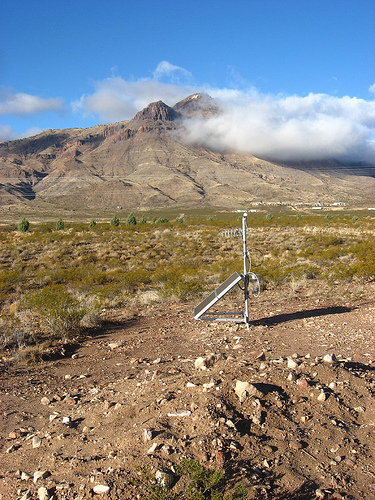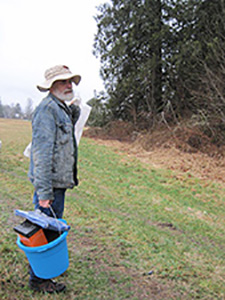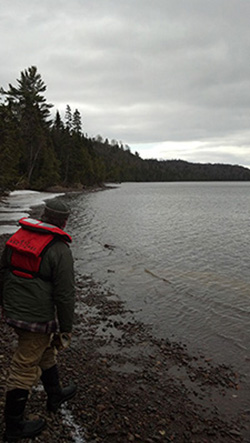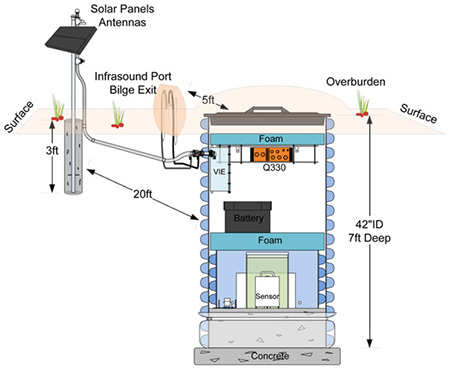Y22D
IRIS PASSCAL Instrument Center, Socorro, NM, USA
The USArray component of the NSF-funded EarthScope project ended its observational period in September 2021 and all remaining close-out tasks concluded in March 2022. Hundreds of seismic stations were transferred to other operators and continue to collect scientific observations. This USArray.org website is now in an archival state and will no longer be updated. To learn more about this project and the science it continues to enable, please view publications here: http://usarray.org/researchers/pubs and citations of the Transportable Array network DOI 10.7914/SN/TA.
To further advance geophysics support for the geophysics community, UNAVCO and IRIS are merging. The merged organization will be called EarthScope Consortium. As our science becomes more convergent, there is benefit to examining how we can support research and education as a single organization to conduct and advance cutting-edge geophysics. See our Joining Forces website for more information. The site earthscope.org will soon host the new EarthScope Consortium website.




By Maia ten Brink
Vacation never stopped Howard Peavey from working. At 9 PM on a Wednesday during his week off, Peavey sat down at the computer and pulled up the online real-time USArray data monitor, a color-coded table showing temperature, humidity, bilge pump activity, battery power, and other state-of-health measures for the earthquake sensors in the USArray Transportable Array. He noticed that Station C40A, located in the middle of Lake Superior on Isle Royale National Park, had stopped sending data. C40A had been troubling Peavey since it was buried in the ground in October 2011.

Howard Peavey carrying a digitizer
after servicing a station in Marblemount, WA.
Photo by Maia ten Brink
Peavey is a service technician for the Transportable Array (TA). He works about three weeks on and one week off, driving all over the country to doctor broken seismic stations. A graying New Mexican with a fierce focus and a skeptical eye, he spends most of his time alone in his car, which functions as a traveling home and office. It’s crammed with laundry, two laptops, cold weather gear, spare sensor cables, GPS antennae, cans of expanding urethane foam, and a solar panel or two.
Peavey got this job with the TA by accident when a friend invited him out for Mexican food. At his last job, he was trying to figure out how to turn off car engines using microwaves. By his own admission, he doesn’t know what he wants to be when he grows up and survives by his wits.
As Peavey looked at the state-of-health channel readings, he considered possible diagnoses: “The energy supply could have been pinched by failure of the modem, its AC-DC power supply, the AC outlet strip, the DC-AC inverter, the low-voltage-disconnect controller, an animal savoring cables between the satellite radio and modem, or a large ill-tempered animal taking great exception to the array of solar panels suddenly appearing in the neighborhood.” In summer, you can only access Isle Royale by ferry. “Commercial boat service from Minnesota resumes in seven months,” Peavey concluded grimly.
Earthquakes are always happening somewhere, and the TA aims to provide 24/7 monitoring of ground vibrations all over North America. In the ten years that the array has rolled from west to east across the continent, it has collected 19 terabytes of data about Earth’s geophysical processes. Each of the 400 stations in the TA gathers six channels of seismic data and 25 channels of data about the station’s “state of health.”
The staff who run the TA focus on “metadata”: the science behind the science. Peavey and other field technicians, along with analysts at the Array Network Facility (ANF) in San Diego and the Data Management Center in Seattle, keep track of the seismometers’ performance to make sure that scientists, students, and civilians can freely download reliable data.
“C40A needed maintenance in the worst way. There was no way in God’s green earth to get to it,” says Peavey’s fellow TA service technician Daniel Knip. “I know it bugged Howard for months. And the first time the ice came off Lake Superior, he bought a sailboat.”
Dan Knip (pronounced “K-NIP”) is an affable Minnesotan of lumberjack build with a checkered background: military training, a Master’s in psychology, a stint in law school, and ballroom dance lessons with his wife. He wears flannel and a pair of black reading glasses with flowers curling around the temples.
When Peavey told Knip that he intended to sail from Grand Portage across Lake Superior in March in a 4.8-meter sailboat, he knew that he’d have a better chance of dissuading Peavey if he pretended to go along with the harebrained plan.
“Howard tries too hard sometimes,” Knip chuckles. “Lake Superior is like 0.1°C in March.” Peavey didn’t even know how to sail.
“You will absolutely not go on that boat,” said Knip’s boss.
“You’ll die, but if you make it, it will be an excellent adventure,” commented another field technician.

On the shore of Isle Royale. Photo by Dan Knip.
Knip acquired two life jackets and met Peavey at the shore of Lake Superior. After testing the water (freezing), Peavey was convinced to scrap the sailboat scheme. Airplanes on skis couldn’t land on the weak ice. Finally, they found a commercial boat to shuttle them over to the island, and then they took a rubber raft to shore, pounded by waves.
Peavey and Knip carted their equipment uphill to the station, which looks like a small bump of dirt about twenty meters from a pole with some solar panels and a communication antenna attached to the top. They dug away soil covering the vault, which helps stabilize the temperature inside and protect it from ice and rain.
Peavey climbed down into the vault, a plastic tank just big enough to stand in, buried about three meters underground. He stood on a flat shelf of grey Styrofoam that splits into two half moons. He picked up the other half, which revealed a lower lever with what looks like a PVC pipe screwed into the concrete floor. The PVC pipe was filled with sand, and inside the sand was the seismometer.
“The seismometers we use come in two shapes,” explains Bob Busby, TA’s manager. “One looks like a basketball on three little legs, and the other looks like a cylinder. They don’t have any lights or parts on the outside, but on the inside they are sort of like $20,000 Swiss watches. They are extremely precise mechanical pendulum arrangements with electronics, balancing springs, motors, and so on.”
Seismometers register vertical motion, north-south motion, and east-west motion as a voltage. Computers in the upper part of the vault measure the voltage output from the seismometer and send those measurements to the ANF data collection center in California via phone lines, satellite radios, and cell phone networks.

USArray vault design (click here for more information)
Each station is powered by solar panels and runs on seven Watts, about as much as an LED light. Batteries stored in the vault collect excess power to operate the station in bad weather. The entire TA produces about 11 gigabytes of data per day.
Peavey found water in the digitizer that transforms the seismometer’s voltage readings. He replaced the broken pieces, handed them up to Knip, and then they re-buried the vault. It took them about two hours to get the station back on the air. The crew of the commercial boat told Peavey and Knip it was the earliest they had ever crossed Lake Superior.
It is a truth universally acknowledged by anyone who has ever used a printer that machines break in mysterious ways. The #1 cause of TA station failures is “unknown cause.” From Peavey’s perspective, leaks present the most urgent problem because water does most damage to the electrical equipment. Every week, he makes a list of high-priority fixes and tries to split the work between himself and Knip based on their current locations.
“Lots of times I don’t know when I finish a station where the next station will be,” Knip says. “I get on the web and see what’s broken nearby and sort of draw a path in the direction of travel.”
Since 2006, Peavey’s Toyota RAV4 has racked up more than 800,000 kilometers. “I’ve driven through Texas for miles in the dark and driven until I can’t drive another mile, and stopped at the first hotel on the highway,” says Knip. When he walked in, the woman at the front desk said, “Well, gosh! I haven’t seen you for a while!”
“Who knows?” laughs Knip. “Who knows where I’ve been?”
The time spent driving relative to the time spent actually fixing a station can be pretty absurd. Knip once drove 800 kilometers through a snowstorm to Montana in order to plug in an electrical cord that the wind had shaken loose. About once a year, he has to hike or ski out with a deer sled full of solar panels to a station that cannot be accessed from winter roads. “You can get stuck in places in the wintertime that you would never be stuck in the summer,” he says. “In the rain, I’ve had to cross streams on foot to see if the truck could get across, and then come back.”
Peavey and Knip brave blizzards, bail out flooded vaults, and drive 16 kilometers per hour for 12 hours on “roads people haven’t been on since the Civil War, and maybe they took a goat.” Meanwhile, analysts and programmers at the ANF in San Diego, California, do quality control on the data to keep the TA running reliably and go surfing on their lunch breaks. Rob Newman created the web tools that keep Peavey and Knip appraised of stations’ state-of-health statistics. He had four surfboards behind his office door and brought his dog Nia to work, where she would lounge on his couch.
“My working conditions were so much better than those guys,’ so the way that I would compensate for that would be to work hard and make the best tool for them,” says Newman. “For a guy who is in the field who has only got a tiny laptop or smartphone to figure out and fix a problem with the station, you want to make it as easy as possible.”
The Transportable Array has set a new standard for seismic arrays, thanks to Peavey, Knip, the analysts at the ANF, and the rest of the TA team.
“Everybody I know in the seismic network world wants to replicate what the TA did,” says Newman.
According to Göran Ekström, a professor at Columbia University whose research uses data gathered by USArray, the TA outperforms other seismic networks around the world. The metadata TA has collected allows seismologists to better calibrate between seismometers at different locations to figure out how waves generated by earthquakes lose amplitude as they pass through rock. Those measurements help scientists make inferences about structures beneath Earth’s surface. “Quality is the greater challenge, not the quantity,” says Ekström. “TA has shown us that you can achieve it.”
And what became of the sailboat? After the whole icy ordeal, Knip bought it off of Peavey to prevent his landlubber colleague from attempting another ill-fated voyage.